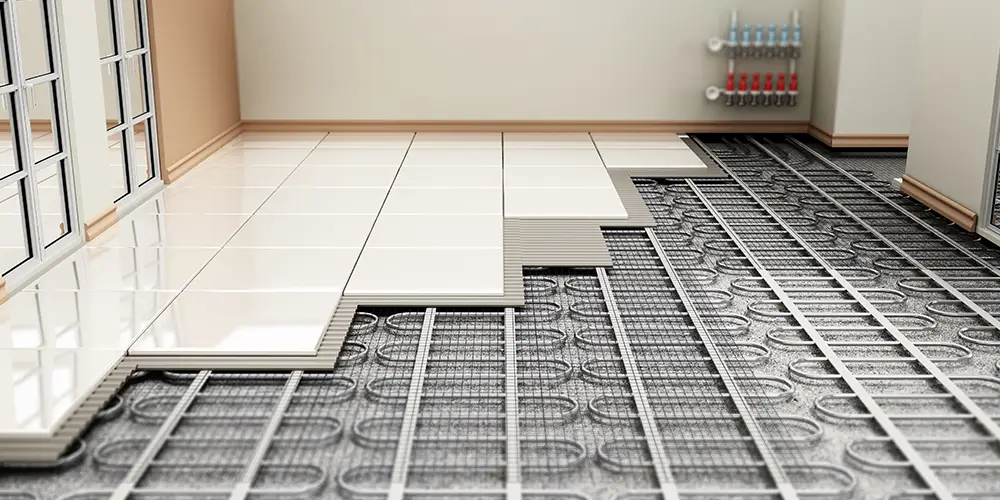What Is Radiant Heating?
Radiant heating uses infrared radiation to warm surfaces rather than the air in a room. It heats people and objects directly, like the sun’s infrared energy.
A forced air furnace, in comparison, pushes hot air through ducts and vents into a room. Radiant heating feels more natural than forced air, especially in areas with high ceilings or large open spaces, where traditional heating methods may struggle to maintain comfort.
Radiant elements are warm to the touch but never hot enough to burn. Radiant heating systems are the most efficient on the market, bar none. They’re invisible if installed under floors, in ceilings, and inside walls, making them a favorite with interior designers for upscale homes and commercial spaces.
In-floor radiant systems are compatible with various flooring options, including tile, most hardwood, and carpet. This allows homeowners to choose the flooring that suits their style and budget without sacrificing the comfort and efficiency of radiant heating.
Electrical Radiant Heating vs. Hydronic
Hydronic radiant heating systems circulate heated fluid. Electric systems use resistance wires to generate heat, like a toaster.
Hydronic Radiant Heating
Hydronic systems circulate hot water or antifreeze through a network of pipes or tubes installed in the floor, walls, or ceilings. As the water passes through the lines, it releases heat and warms the surrounding area. Hydronic systems are highly efficient, with very little heat loss.
However, installing a hydronic system is more involved than an electric system as it requires pumps, valves, and other components; fluid must pass through a boiler or water heater (usually placed in a garage or basement). It can be difficult and expensive to retrofit a hydronic radiant system; the best installation time is during new construction or remodeling.
Electric Radiant Heating
Electric radiant heating systems consist of electric heating elements, typically in the form of resistance wires or mats installed under the floor or in the walls or ceilings of a building. The resistance wires convert electricity into heat, which is then radiated outward.
Electric radiant heating systems are often used to supplement forced air heating and can be installed in new construction or retrofitted into existing buildings. Electrical radiant systems are less efficient than hydronic. However, installation is relatively simple and can sometimes be done by the homeowner.
Radiant Heating Pros & Cons
Benefits of Radiant Heating
- Increased comfort: Radiant heating warms surfaces, not air. The heat feels natural; there are no cold spots.
- Energy efficiency: Radiant systems use less energy. They work less hard to maintain a comfortable temperature.
- Reduced noise: Radiant systems don’t use fans or blowers, so they’re much quieter than other heating methods.
- Improved air quality: There’s no circulated dust, allergens, or outside air pulled through dirty ducts.
- Long lifespan: A well-maintained hydronic radiant heating system can last 20 years or more — substantially longer than a forced air furnace.
- Aesthetics: Components are hidden out of sight, giving your living space a clean look and feel.
- Environmental benefits: Radiant heating systems don’t release pollutants into the air, making them an eco-friendly option.
- Zone heating: Radiant systems are easy to zone, allowing you to keep different areas of your home at different temperatures.
Drawbacks of Radiant Heating
- High initial cost: Radiant heating systems can be more expensive to install than other heating methods, particularly if retrofitted into a finished home. Hydronic systems have intricate piping and pumps requiring professional installation.
- Flooring limitations: In-floor radiant heating systems may not be compatible with some hardwoods or flooring.
- Slow to heat: Radiant systems take longer to heat a space than other heating methods, which can be an issue in frigid climates.
- Inefficiency in uninsulated spaces: Poorly designed systems can lose heat through the walls, roof, and even the ground.
- Risk of leaks: Hydronic systems can develop leaks and damage floors, walls, and ceilings, leading to costly repairs.
Why Hydronic Radiant Heat Floors Are the Holy Grail of Bathrooom Heating Comfort
Radiant floors are more efficient and offer better temperature control than radiant walls and ceilings.
- Heat naturally rises.
- As heat rises from the floor, it warms the objects and people in the room, not just air near the ceiling.
- Tubing can be more evenly distributed throughout a room and easily controlled with thermostats and timers.
- Radiant flooring doesn’t take up wall or ceiling space. It doesn’t affect a room’s aesthetic, and it doesn’t get in the way if you’re upgrading ceiling lighting or electrical wiring.
Points to Consider for Your Radiant Floor Installation
Hydronic or electric?
Generally speaking, a fluid-based system (hydronic) offers better comfort and efficiency than resistance mats. But it requires careful planning and professional installation.
What heating components will you use?
A hydronic underfloor heating system relies on a boiler or heater to warm the fluid in its tube tubes. It may also need a pump. Systems are only as efficient as their heating elements and overall design.
How will you prevent heat loss into the ground?
Heat can pass uselessly into the surrounding soil beneath your home in a poorly designed underfloor system. You’ll need a professional to evaluate local soil conditions and install polyurethane or polystyrene under-slab insulation.
How will you prevent heat loss via floor framing?
Spaces between the framing timbers in floors can allow heat to escape. Spray-on insulation, rigid insulation panels, and fiberglass batt can prevent heat loss as long as they have enough R-value to match the demands of your climate and home.
How will radiant heating affect wood flooring?
A well-designed system preserves your wood flooring by considering the type of wood used, the techniques to cut the wood, and the humidity levels inside your home.
How will radiant heating work with hard flooring?
Radiant heating is compatible with slate, tile, stone, brick, terrazzo, and marble. However, floors should have expansion and control joints allowing the masonry to withstand the temperature changes produced by underfloor heating. Concrete floors will likewise shrink and expand with temperature changes; the system design should account for this to prevent cracks in masonry and concrete.
How will you lay the hydronic tubing?
A skilled professional will consider all variables when deciding how to space the lines of tubing for optimal comfort and efficiency.
How will you customize the system for your home?
Different areas of your home will require different levels of heating. A professional can help you divide the house into zones, with separate thermostats and controls, to personalize the system for each space in your home.
Will you need a backup heat system?
If you live in an area with extreme winters, you should consider adding a backup heating system to your home. This can be especially important if you rely on radiant flooring as your primary heat source.
Maintenance Tips for a Hydronic Radiant Heating System
Like all plumbing and appliances, hydronic radiant heating systems need occasional maintenance (radiant electric mats and panels are more or less maintenance-free):
- Check the fluid level and pressure of the system regularly. Both should be within the recommended range.
- Flush the system at least once a year to remove any sediment or debris that may have accumulated in the pipes.
- Inspect the system periodically for leaks or other signs of damage.
- Drain the expansion tank and refill it with air as required.
- Have a professional check the system and boiler annually.
- Keep the area around the boiler and the pipes clean and free from debris.
- Keep an eye on the temperature and pressure gauges. If they’re outside normal ranges, you may have a problem.
Orange Coast Plumbing Installs & Maintains All Radiant Heating Systems
The plumbing, heating, and cooling experts at Orange Coast Plumbing have years of experience designing and installing radiant heating systems for homes, offices, and large commercial buildings. Please call us to learn more about radiant heating, determine if it’s right for your lifestyle and budget, or schedule a free estimate for installation.
FAQs about Hydronic Heating Systems
Q: What’s a hydronic heating system?
A: A hydronic heating system uses water or another liquid medium to transfer heat throughout a building. The heated liquid is circulated through pipes to radiators or underfloor heating systems, providing uniform warmth.
Q: How does a hydronic heating system work?
A: The system works by heating water in a boiler and then pumping this heated water through a network of pipes installed under floors or to radiators. The heat from the water is then radiated into the room.
Q: What are the benefits of hydronic heating compared to traditional heating methods?
Q: Hydronic heating offers several advantages, including more even heat distribution, higher energy efficiency, quieter operation, and the ability to use multiple heat sources. It also allows for zoning control, letting you heat specific areas of your home as needed.
Q: Can hydronic heating systems also cool?
A: Yes, hydronic systems can be adapted for cooling by circulating chilled water through the pipes. However, additional equipment and considerations are needed for full cooling capabilities.
Q: What energy sources can power a hydronic heating system?
A: It can be powered by natural gas, oil, electricity, solar power, and even geothermal energy.
Q: How energy efficient is hydronic heating?
A: It’s highly efficient due to its ability to circulate warm water through insulated pipes, minimizing heat loss and reducing energy consumption compared to forced-air systems.
Q: Is it possible to retrofit a hydronic heating system in an existing home?
A: While it’s more common to install hydronic heating during construction, you can retrofit a system. However, you have to consider existing flooring and the need for a boiler room.
Q: How much maintenance does a hydronic heating system require?
A: Hydronic systems generally require less maintenance than traditional heating systems, but you should conduct checks to ensure the boiler is functioning correctly and there are no leaks or blockages in the pipes.
Q: Can I install a hydronic heating system myself?
A: We recommend professional installation to ensure efficiency and safety.
Q: What’s the lifespan of a hydronic heating system?
A: With proper maintenance, a hydronic heating system can last 25 years or more — much longer than a forced-air furnace.


